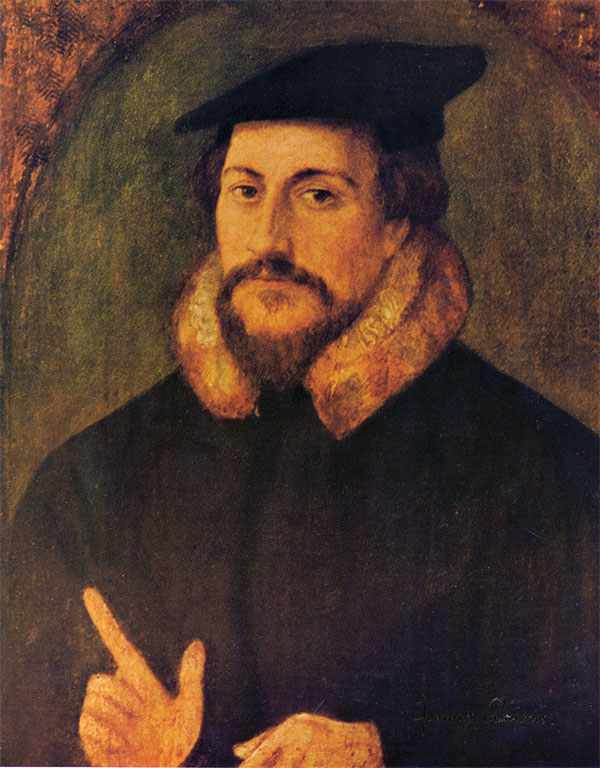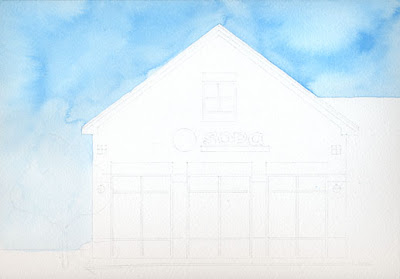Viewing: Blog Posts Tagged with: holbein, Most Recent at Top [Help]
Results 1 - 4 of 4
Blog: Drawing a Fine Line (Login to Add to MyJacketFlap)
JacketFlap tags: Christmas card, watercolors, Holbein, Turner, Daniel Smith, Winsor Newton, bad storm, Add a tag
Blog: OUPblog (Login to Add to MyJacketFlap)
JacketFlap tags: Books, History, Religion, prophet, holbein, Europe, calvin, Humanities, John Calvin, *Featured, calvinism, John Calvin as Sixteenth-Century Prophet, Jon Balserak, balserak, Add a tag
By Jon Balserak
For some, it was no surprise to see a book claiming that John Calvin believed he was a prophet. This reaction arose from the fact that they had already thought he was crazy and this just served to further prove the point. One thing to say in favor of their reaction is that at least they are taking the claim seriously; they perceive correctly its gravity: Calvin believed that he spoke for God; that to disagree with him was to disagree with the Almighty ipso facto.
The belief may, of course, appear utterly astonishing and bizarre to us today. While I’m sympathetic with such astonishment, I don’t share it. This is not necessarily because I believe Calvin was a prophet. It’s rather because I know him well enough to know that such a belief is entirely in keeping with his character and I suppose I’ve grown accustomed to it. Most of what comes out of his mouth or flows from his pen carries with it, it seems patently clear to me, a prophetic tone and energy. There’s no question in my mind that he held that the heavens themselves opened when he opened his mouth.
I have friends who ask with some chagrin: “didn’t Calvin feel the same sense of utter uncertainty, confusion, and awkwardness with respect to his own place in the universe that people in the twenty-first century do? Wasn’t he aware of his own weaknesses?” If so, the logic follows, how could he have become convinced that he was a divine messenger since this assumes a certain sense of faultlessness? For one of us to believe ourselves a prophet seems impossible, so, what of Calvin? Didn’t his inner reservations and neuroses weigh on his self-conception and convince him that he couldn’t possibly be the mouthpiece of the Divine? My answer is a simple “no.” I don’t think he believed that he erred in his service of God. Ever.

John Calvin by Hans Holbein the Younger. Public domain via Wikimedia Commons.
Let us recall that it’s Calvin who indicted the greatest theologians with the charge that they had mixed hay with gold, stubble with silver, and wood with precious stones (a reference to the Apostle Paul’s warning to those who had corrupted their labors in God’s service in 1 Corinthians 3: 15). He indicted Cyprian, Ambrose, Augustine, and some from what he referred to as more recent times, such as Gregory and Bernard. He said of these individuals that they could only be saved on the condition that God wipe away their ignorance and the stain which corrupted their work. They could only be saved as through fire. He even said this of Augustine, the Theologian par excellence for everyone in Early Modern Europe. Let us recall as well that Calvin could write in 1562, just two years before he died, that if anyone were his enemy, then they were the enemies of Christ. He goes on in this writing, entitled Responsio ad Balduini Convicia, to say that he had never taken up a position out of a hostile personal motive or being prompted by spite. He insists, in fact, in language that is astounding to read that anyone who is his enemy feels this way about him because they oppose the good of the church and they hate godly teaching. This is Calvin. This is the prophet; the one to whom the mantle of Elijah had been passed.
The natural question to ask at this point is whether Calvin believed that his writings should be added to the canon of Scripture? It might seem only logical, according to what I’m arguing, that he did. However it would, of course, be extremely difficult to justify such a claim. But I don’t think that’s all that can be said on the question. For there is a logic to the idea that not only Calvin but also Zwingli, Luther, Knox, and others who believed themselves raised up as prophets might have thought this. There are, moreover, numerous vocational, temperamental, theological, strategic, psychological, doctrinal, and relational reasons that would need to be taken into account before drawing a conclusion one way or the other on the question. I don’t put it out of the realm of possibility that Calvin could have believed this, at least at some level. He did, after all, tell his fellow ministers on his death bed that they were to “change nothing,” suggesting that the foundation he had laid was perfect and, thus, that the repository representing that foundation—namely, his biblical commentaries, lectures, theological treatises, and magnum opus, The Institutes of the Christian Religion—should serve as the origin from which the Christian church was to be rebuilt. So I would not be utterly shocked if he did, in fact, believe that his oeuvre should be made part of the canon of Scripture. Unfortunately, we will never know.
Jon Balserak is currently Associate Professor of Religious Studies at the University of Bristol. He is an historian of Renaissance and Early Modern Europe, particularly France and the Swiss Confederation. He also works on textual scholarship, electronic editing and digital editions. His latest book is John Calvin as Sixteenth Century Prophet (OUP, 2014).
Subscribe to the OUPblog via email or RSS.
Subscribe to only religion articles on the OUPblog via email or RSS.
The post John Calvin’s authority as a prophecy appeared first on OUPblog.
Blog: Drawing a Fine Line (Login to Add to MyJacketFlap)
JacketFlap tags: watercolor, Sopa, Holbein, Windsor Newton, Add a tag
Here's the start of my rendering of this restaurant, Sopa.
First thing I did was get a line drawing.
I enlarged the photo (scanned it, enlarged it in Photoshop), made a grayscale out of it and printed it out.
I traced over it on my lightbox, correcting the distortion and taking out the offending bits like the power pole. I just wanted to get all the basic lines and shapes down here.
I put the new line drawing on my lightbox and transferred it to my watercolor paper.
The scan made bad edges, but I just left them here. They're not really on the paper!
I forgot those couple of lines on the right side, but its OK, I'll fix that later, its easy.
I lightened the drawing by going over it with a white eraser, lightly lightly lightly. No hard pressure, because I don't want to ruin the tooth of the paper.
I put in a wash of sky with a mixture of Holbein Blue Grey and Horizon Blue, being careful around the edge of the roof. I just kind of let the paint do whatever it wanted to.
Next up are the bricks. I decided to do washes of 'brick color' over the whole area, then will come back in with pencil at the end and do some white lines.
This is two layers of Holbein Light Red and Windsor Newton Burnt Sienna. I carefully went around the signage and windows and other bits. It looks rough, but I purposely wanted to get some variation in the paint to give it some interest.
It was kinda bright, so I went over it all with a light wash of WN Caput Mortuum Violet.
I may do another wash or two on the bricks, then I'll move on to the other parts.
Stay tuned!
All images are ©Paula Pertile and may not be copied or used for any reason.
Blog: Neil Gaiman (Login to Add to MyJacketFlap)
JacketFlap tags: Japan, Odd and the Frost Giants, ANNIE, how to arrive in hotels, Add a tag
Not a lot to report. I flew Virgin to Tokyo -- I had fond memories of Virgin Upper Class from about a decade ago, when I flew once it to LA and found it spacious and pleasant and really nice. It's nowhere near as good as it was back then, but the seats turn into all-the-way-flat beds, and that on its own is wonderful.
Less impressed when I realised, when I got off the plane, that one of the bottles of Talisker I'd bought in duty free as presents for my Japanese hosts (given the Skye connection with Stardust it seemed appropriate) was no longer in the duty free bag. I hope whoever wound up with it enjoys it.
I worked on Odd and the Frost Giants on the plane, typing up stuff that was handwritten. Odd is a slim book I'm writing -- a novelette, I guess -- that will be published for World Book Day 2008.
(I lost the notebook [left it on the plane from China to Amsterdam, en route to Budapest] that had the next chapter handwritten in it. So, having no other option, I'll shrug and write it again. Mostly it was just the fox talking and the bear interrupting anyway.)
Arrived in Tokyo and had the smoothest experience walking through any airport I've ever had -- passport, baggage, everything was simply ready as I got there, and I was out of the airport before the plane was even meant to land.
I was introduced to my people at UIP Japan, and put in a car with my driver and my security person (I have a security person here) while the UIP people followed in a minibus. And then I got to the hotel...
If you ever saw the film ANNIE, the bit where she arrives at the Warbucks Estate and is introduced to everyone while walking through the building, that was what it was like arriving in my hotel. I tumbled out of the car and was swept inside a tide of people into the hotel, led by the general manager while shaking hands with er... everyone, or that was how it seemed... and soon found myself in the most beautiful hotel room I think I've ever been in (and I have been in many lovely hotel rooms around the world), with a view over Tokyo that's astonishing. The hotel has only been open for about two weeks, and it still has that new-carpet smell. The hotel room doesn't feel like anyone's stayed in here before. I was shown how to work things, and I needed to be shown -- it's the HAL 2000 of hotel rooms, with all sorts of strange technological innovations hidden away. The toilet seats that rise to greet you when you nervously open an unmarked door to see what's in there are the least of it.
(Having a panda on my lap was better than this hotel room. But as hotel rooms go, it's the best. It has an old telescope too, for looking at the stars, or at the scenery, or something.)
I checked the schedule -- the 43 interviews I was doing in two days has shrunk to a slightly more manageable 37. The Kadokawa event on Friday night should be enormously fun, presuming that I can still remember by then a) who I am and b) how to sign my name.
Today I get to recover, but plan instead to go out to Studio Ghibli and pay my respects there, something I've wanted to do since they first invited me, when I was working on Princess Mononoke, all those years ago.






